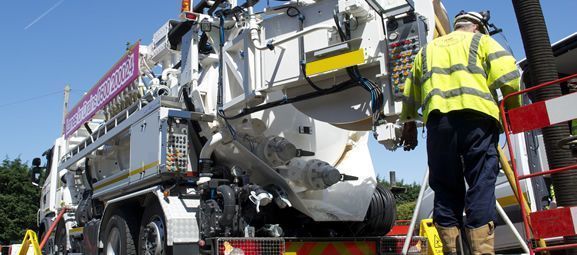Lanes Group digs deep for sewer adoption survey at new housing site

Drainage engineers at the Lanes Group depot in Cardiff, South Wales, have dug deep to carry out one of the most challenging sewer adoption cleaning and survey projects for a new housing development in recent years.
Their work demonstrates the higher levels of productivity Lanes Group can deliver, resulting in overall cost reductions and greater assurance that complex sewer adoption projects will be completed efficiently, safely, and to deadline.
The Lanes team was called in to carry out the sewer adoption clean and survey at the housing development just outside Cardiff, and found that most of the manholes and the pipe-work were full of silt, slurry and debris.
Over a three-week period, the team cleaned out more than 50 manholes and over 1,500 metres of drainage pipe, removing more than 250 tonnes of waste material in the process.
Lanes Cardiff Area Development Manager David Lewis said: “We are very experienced at carrying out sewer adoption clean and survey work for both new housing developments and commercial building projects.
“Usually, we find that there is some silt in the drain lines. We might also find some defects that need correcting before the drains can be adopted by the water company as part of the overall sewer system.
“But what we found on this site, was quite exceptional. The housing development was on a hillside, and the area has experienced quite a bit of rain during the building process.
“This had led to a lot of building materials, mud and debris gathering washing through the site and gathering in the drainage system. Many of the manholes were filled to the brim, and had to be dug out.”
Material found in the manholes and drainage lines, which were between 100mm and 300mm in diameter, included bricks, blocks, hardcore, sand, silt, cement, and steel reinforcement waste.
Three attenuation tanks at the bottom of the site were also found contain similar waste, and had to be dug out.
Sewer adoption is a key element in the completion of any new building development, and is governed by a process called a Section 104 agreement which is required by the Water Industry Act 1991.
For this sewer adoption project, as with most others, the development’s groundworks team was under time pressure and wanted the drainage system to be passed fit for adoption as quickly as possible.
Lanes Group deployed a CCTV drainage survey team and up to two jet vac tankers on the project every day to complete what was a difficult task. One of the jet vac tankers was one of Lanes’ fleet of recycling tankers, which was ideally suited to the project.
David Lewis said: “Jet vac recyclers can clean and reuse their water several times, so can stay in position vacuuming material from drainage lines for longer before they have to refill their tanks.
“For our sewer adoption client in this case, it meant more debris could be lifted, and manholes and drain lines could be cleaned more quickly. The process uses less water, so is less costly and more sustainable as well.
“It reflects the fact that Lanes Group has the capacity to offer quicker turnarounds for sewer adoption work like this, and higher levels of onsite productivity, which contributes to greater assurance that deadlines will be achieved and reduced final costs for the client.”
On average, two tanker-loads of waste, equating to eight to 12 tonnes of material, were removed from the drainage system and unloaded on site, for disposal by the groundworks contractor, every day.
David Lewis said: “Our team had to carry out confined entries to manholes and the attenuation tanks to dig out a substantial amount of waste material by hand. It was tough and dirty work.
“It also had to be carried out in a controlled and step-by-step way to ensure the debris was removed, and not just pushed into another part of the drainage system.
“We’re pleased to say, the client was impressed with the skills, effort and productivity of our team, in overcoming challenging conditions and completing the work quickly and to a very high standard. They are now considering using our services for further sewer adoption work at other sites.”
As each section of the surface and foul system was cleared of debris and jetted clean, a CCTV drainage survey could be carried out, with HD video footage supplied to show that the system was fit for adoption.







